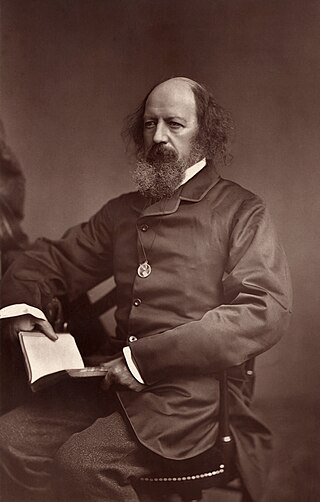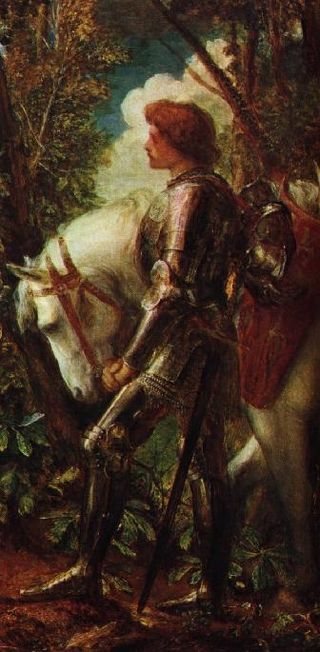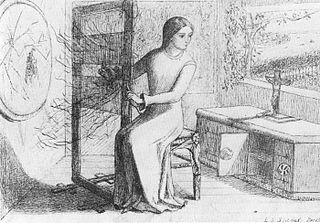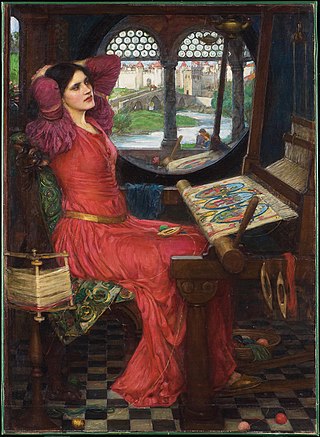Summary
When Bill, an impoverished Cambridge student, is even unable to pay for his mother's funeral, his thoughts turn to crime. However, a friend warns him that "To have no money is to join the aristocracy, Bill. When the day comes for you to have it, you will have left the aristocracy, never to return." [5] Another central character, Helen, an undergraduate reading English literature, lacks stability in her life and finds her main solace in poetry and particularly in the romantic medieval work of Tennyson. Her obsession with The Lady of Shalott, and her identification with the lady of the poem, bring her to a fatal ending. [6] Helen has been seduced by the medieval romances of the Victorian era but does not wish to be seduced by Bill. Lance, a scientist, hopes to save the world, but the effect of his experiments on Helen is less positive. Meanwhile, the Cambridge rapist is at large. "This is the world of bedsitter girls, of Auden and Betjeman and Brian Patten." [7] By buying a Donald Duck mask for bank robbing purposes, Bill unwittingly identifies himself with the rapist. [8]
In the course of a week during the University's Michaelmas term, the tensions and interplay between the leading characters lead not only to bank robbery, but also to ritual castration, transvestism, and a fatal car crash. "From the Whipple Museum to the University Arms Hotel, intellectuals and tourists turned pale. What could have caused it, this catastrophic sound?" [9]
The novel includes many quotations, not only from Tennyson but also from Thomas Hood, William Thackeray, and W. H. Auden. [6]

King Arthur is a legendary king of Britain, and a central figure in the medieval literary tradition known as the Matter of Britain.

Alfred Tennyson, 1st Baron Tennyson was an English poet. He was the Poet Laureate during much of Queen Victoria's reign. In 1829, Tennyson was awarded the Chancellor's Gold Medal at Cambridge for one of his first pieces, "Timbuktu". He published his first solo collection of poems, Poems, Chiefly Lyrical, in 1830. "Claribel" and "Mariana", which remain some of Tennyson's most celebrated poems, were included in this volume. Although described by some critics as overly sentimental, his verse soon proved popular and brought Tennyson to the attention of well-known writers of the day, including Samuel Taylor Coleridge. Tennyson's early poetry, with its medievalism and powerful visual imagery, was a major influence on the Pre-Raphaelite Brotherhood.

Guinevere, also often written in Modern English as Guenevere or Guenever, was, according to Arthurian legend, an early-medieval queen of Great Britain and the wife of King Arthur. First mentioned in popular literature in the early 12th century, nearly 700 years after the purported times of Arthur, Guinevere has since been portrayed as everything from a fatally flawed, villainous and opportunistic traitor to a noble and virtuous lady. Many records of the legend also feature the variably recounted story of her abduction and rescue as a major part of the tale.

Idylls of the King, published between 1859 and 1885, is a cycle of twelve narrative poems by the English poet Alfred, Lord Tennyson which retells the legend of King Arthur, his knights, his love for Guinevere and her tragic betrayal of him, and the rise and fall of Arthur's kingdom.

Galahad, sometimes referred to as Galeas or Galath, among other versions of his name, is a knight of King Arthur's Round Table and one of the three achievers of the Holy Grail in Arthurian legend. He is the illegitimate son of Sir Lancelot du Lac and Lady Elaine of Corbenic and is renowned for his gallantry and purity as the most perfect of all knights. Emerging quite late in the medieval Arthurian tradition, Sir Galahad first appears in the Lancelot–Grail cycle, and his story is taken up in later works, such as the Post-Vulgate Cycle, and Sir Thomas Malory's Le Morte d'Arthur.
The Queen of Orkney, today best known as Morgause and also known as Morgawse and other spellings and names, is a character in Arthurian legend in which she is the mother of Gawain and Mordred, both key players in the story of King Arthur and his downfall. In early texts, Mordred's father is her husband, King Lot of Orkney, with whom she may also have various other children. In later versions, including the seminal Le Morte d'Arthur, Mordred is the offspring of Arthur's accidental incest with Morgause, his estranged half-sister. There, she is furthermore a sister of Morgan le Fay, as well as the mother of Gareth, Agravain, and Gaheris, the last of whom murders her.

"The Lady of Shalott" is a lyrical ballad by the 19th-century English poet Alfred Tennyson and one of his best-known works. Inspired by the 13th-century Italian short prose text Donna di Scalotta, the poem tells the tragic story of Elaine of Astolat, a young noblewoman stranded in a tower up the river from Camelot. Tennyson wrote two versions of the poem, one published in 1832, of 20 stanzas, the other in 1842, of 19 stanzas, and returned to the story in "Lancelot and Elaine". The vivid medieval romanticism and enigmatic symbolism of "The Lady of Shalott" inspired many painters, especially the Pre-Raphaelites and their followers, as well as other authors and artists.

Rudolf John Frederick Lehmann was an English publisher, poet and man of letters. He founded the periodicals New Writing and The London Magazine, and the publishing house of John Lehmann Limited.
Felicity Pulman is an Australian author with an interest in crime, history and fantasy. Her novels Ghost Boy, the Shalott trilogy and A Ring Through Time reflect her fascination with such possibilities as knowledge travelling through time, ghosts, parallel realities and reincarnation. Her medieval crime series for older teenagers, The Janna Mysteries, indulges her love of crime, history, plants and herbal healing. Note: The Janna Mysteries have now been repackaged as The Janna Chronicles, published by Momentum/Pan Macmillan Australia. Her first novel for adults, titled I, Morgana, a retelling of the 'bad girl' of Arthurian legend, has also been published by Momentum/Pan Macmillan, as has the sequel: The Once and Future Camelot, written while Felicity spent several months on a writer's fellowship in the UK in 2015. These novels are now available as ebooks from any ebook retailer; print versions are available through Pan Macmillan Australia. Her short stories for adults have won several awards. Many have also been published, as have Felicity's numerous articles on various topics including writing and the creative process. Felicity is a popular presenter at schools, conferences and writers festivals, where she talks about her work and/or gives workshops in a variety of genres for students and budding authors. You'll find more about Felicity and her novels on her website: www.felicitypulman.com.au. Pulman has also been involved in the Making Tracks series for students.

The Lady of Shalott is a painting of 1888 by the English painter John William Waterhouse. It is a representation of the ending of Alfred, Lord Tennyson's 1832 poem of the same name. Waterhouse painted three versions of this character, in 1888, 1894 and 1915. It is one of his most famous works, which adopted much of the style of the Pre-Raphaelite Brotherhood, though Waterhouse was painting several decades after the Brotherhood split up during his early childhood.
Kairo-kō: A Dirge is a 1905 novel by the Japanese author Natsume Sōseki. The earliest, and only major, prose treatment of the Arthurian legend in Japanese, it chronicles the adulterous love triangle between Lancelot, Guinevere, and Elaine of Astolat.

"Mariana" is a poem by Alfred, Lord Tennyson, published in 1830. The poem follows a common theme in much of Tennyson's work—that of despondent isolation. The subject of "Mariana" is a woman who continuously laments her lack of connection with society. The isolation defines her existence, and her longing for a connection leaves her wishing for death at the end of every stanza. The premise of "Mariana" originates in William Shakespeare's Measure for Measure, but the poem ends before Mariana's lover returns. Tennyson's version was adapted by others, including John Everett Millais and Elizabeth Gaskell, for use in their own works. The poem was well received by critics, and it is described by critics as an example of Tennyson's skill at poetry.

"The Deserted House" is a poem written by Alfred, Lord Tennyson in 1830, as part of his collection Poems, Chiefly Lyrical. The poem is characterised by its reliance on short lines which alternate in rhyme and meter to prevent a felicitous feel. In the poem, Tennyson uses the image of a dark house as a metaphor for a dead body.

"Sir Galahad" is a poem written by Alfred Tennyson, 1st Baron Tennyson, and published in his 1842 collection of poetry. It is one of his many poems that deal with the legend of King Arthur, and describes Galahad experiencing a vision of the Holy Grail. The subject of the poem was later included in "The Holy Grail" section of Tennyson's Idylls of the King, but the latter version depicts Galahad as a pious individual who is grimly determined to fulfill his destiny. Sir Galahad, in contrast, depicts Galahad as proud, and has almost cheerful undertones.
David Henry Benedictus was an English writer and theatre director, best known for his novels. His work included the Winnie-the-Pooh novel Return to the Hundred Acre Wood (2009). It was the first such book in 81 years.
La Damigella di Scalot is a thirteenth-century Italian romance novellina, i.e. a very short story, included in the collection Il Novellino: Le ciento novelle antike as the 82nd tale. It tells the story of the unrequited love of the titular Lady of Scalot for Sir Lancelot and the subsequent death of the lady by lovesickness.

I Am Half-Sick of Shadows, Said the Lady of Shalott is a painting by John William Waterhouse completed in 1915. It is the third painting by Waterhouse that depicts a scene from the Tennyson poem, "The Lady of Shalott". The title of the painting is a quotation from the last two lines in the fourth and final verse of the second part of Tennyson's poem:

The Lady of Shalott is an oil painting by the English artist William Holman Hunt, made c. 1888–1905, and depicting a scene from Tennyson's 1833 poem, "The Lady of Shalott". The painting is held by the Wadsworth Atheneum, in Hartford, Connecticut. A smaller version is held by the Manchester Art Gallery.
Emily Marion Harris was an English novelist, poet, and social worker. Many of her writings explored Jewish life in London, and the religious and political conflicts of Jewish traditionalists in the face of increasing assimilation.













